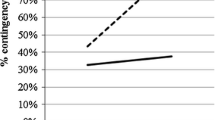Abstract
This study examined the effects of peer-tutoring training on elementary school student communication and collaboration skills when used in conjunction with cooperative learning. Within six classes (grades 2–6) in an inner-city school, cooperative learning pairs were randomly assigned to two groups (control and training). Multivariate analyses of variance (MANOVA) of quantitative data from a systematic observation instrument used over an entire year showed that, in general, the training group surpassed the control group in both communication and collaborative skills. Students in grades 2–3 showed substantially more improvement than students in grades 4–6; also, students with average or below-average reading levels required more time to acquire these skills than did above-average students. The qualitative data further substantiated these findings while revealing a large variation among teachers in implementing cooperative learning.
Similar content being viewed by others
References
Balkcom, S., & Himmelfarb, H. (1993).Success for all. Education research consumer guide, number 5 (Report No. 93-3011). Washington, DC: Office of Research.
Baris-Sanders, M. (1997). Cooperative education: Lessons from Japan.Phi Delta Kappa, 20, 619–624.
Blumenfeld, S.L. (1978).How to tutor, (pp. 15–27), Boise, ID: Arlington House.
Brandt, R. (1987). On cooperation in schools: A conversation with David and Roger Johnson.Educational Leadership, 45(3), 14–19.
Brush, T.A. (1998). Embedding cooperative learning into the design of the integrated learning systems: Rationale and guidelines.Educational Technology Research and Development, 46(3), 5–18.
Candler, A.C., Blackburn, G.M., & Sowell,V. (1981). Peer tutoring as a strategy individualizing instruction.Education, 101(4), 380–383.
Cohen, P., Kulik, J.A., & Kulik, C. (1982). Educational outcomes of tutoring: A meta-analysis of findings.American Educational Research Journal, 19, 237–248.
Cotton, K. (1988).Peer tutoring: Lake Washington High School, Benjamin Rush Elementary School. Effective practices in place: Snapshot no. 5, School Improvement Research Series II.Northwest Regional Educational Lab. (ERIC Document Reproduction Service No. ED 296 413)
Denzin, N.K. (1970).The research act: A theoretical introduction to sociological methods. New York: McGraw-Hill.
Fuchs, L., Fuchs, D., Bentz, J., Phillips, N., & Hamlett, C. (1994). The nature of student interactions during peer tutoring with and without prior training and experience.American Educational Research Journal, 31, 75–103.
Goetz, J.P., & Le Compte, M.O. (1984).Ethnography and qualitative design in educational research. Orlando, FL: Academic Press.
Jenkins, J.R., & Jenkins, L.M. (1985). Peer tutoring in elementary and secondary programs.Focus on Exceptional Children, 17(6), 1–12.
Jenkins, J.R., & Jenkins, L.M. (1987). Making peer tutoring work.Educational Leadership, 44(6), 64–68.
Johnson, D.W., & Johnson, R.T. (1984). Cooperative small group learning.Curriculum Report, 14(1), 2–7.
Johnson, D.W., & Johnson, R.T. (1990). Social skills for successful group work.Educational Leadership, 47(4), 29–33.
Johnson, D.W., & Johnson, R.T. (1992). Implementing cooperative learning.Contemporary Education, 63(3), 173–180.
Johnson, R.T., & Johnson, D.W. (1985). Student-student interaction: Ignored but powerful.Journal of Teacher Education, 36(4), 22–26.
Keyton, J., & Dodson, N. (1996).Exploratory study of children's task groups: Instructional implications. Paper submitted to the Instructional Development Division, Southern States Communication Association.
Lincoln, Y., & Guba, E. (1985).Naturalistic inquiry. Thousand Oaks, CA: SagePublications.
Levin, H., Glass, G., & Meister, C. (1984).Cost-effectiveness of four educational interventions. Stanford, CA: Institute for Research on Educational Finance and Governance, Stanford University.
Levine, M. (1986). Docemur docendo (He who teaches, learns).American Educator, 10(3), 22–25, 48.
Mevarech, Z.R. (1994). The effectiveness of individualized versus cooperative computer-based integrated learning systems.International Journal of Educational Research, 21(1), 39–52.
Miller, L.J., Kohler, F.W., Ezell, H., Hoel, K., & Strain, P.S. (1993). Winning with peer tutoring: A teacher's guide.Preventing School Failure, 37(3), 14–18.
Morris, L.L., & Fitz-Gibbon, C.T. (1978).How to measure program implementation (1st ed.). Beverly Hills, California: Sage Publications.
Nath, L.R., Ross, S., & Smith, L. (1996). A case study of cooperative learning in elementary classrooms.The Journal of Experimental Education, 64(2), 116–136.
Niedermeyer, F.C. (1970). Effects of training on the instructional behaviors of student tutors.The Journal of Educational Research, 64, 119–123.
Palincsar, A.S., & Brown, A.L. (1984). Reciprocal teaching of comprehension fostering and Comprehension monitoring activities.Cognition and Instruction, 1, 117–175.
Patton, M.Q. (1990).Qualitative evaluation and research methods (2nd ed.). Newbury Park, CA: Sage Publications.
Shapiro, E.S. (1988). Preventing academic failure.School Psychology Review, 17(4), 601–13.
Slavin, R.E. (1987). Cooperative learning: Can students help students learn?Instructor, 96(7), 74–78.
Slavin, R.E. (1988). Cooperative learning and student achievement.Educational Leadership, 46(2), 31–33.
Slavin, R.E. (1991). Synthesis of research on cooperative learning.Educational Leadership, 48(5), 71–82.
Slavin, R.E. (1995).Cooperative learning: Theory, research, and practice. Boston: Allyn and Bacon.
Slavin, R.E., & Madden, N.A. (2001). Summary of research on Success For All and Roots and Wings. In R.E. Slavin & N.A. Madden (Eds.),Success for all: Research and reform in elementary education (pp 12–48). Mahwah, NJ: Lawrence Erlbaum Associates.
Slavin, R.E., Madden, N.A., Dolan, L.J., Wasik, B.A., Ross, S.M., & Smith, L.J. (1994). Whenever and wherever we choose: The replication of success for all.Phi Delta Kappan, 75(8), 639–640, 642–647.
Slavin, R.E., Stevens, R.J., & Madden, N.A. (1988). Accommodating studient diversity in reading and writing instruction: A cooperative learning approach.Remedial and Special Education, 9(1), 60–66.
Stringfield, S., Ross, S., & Smith, L. (Eds.). (1996).Bold plans for school restructuring. Mahwah, NJ: Lawrence Erlbaum Associates, Inc.
Warger, C.L. (1991).Peer tutoring: When working together is better than working alone. Research & Resources on Special Education, Number 30. Council for Exceptional Children, Reston, VA. (Eric Document Reproduction Service No. ED 345 459)
Webb, M. (1988). Peer helping relationships in urban schools.Equity and Choice, 4(3), 35–38.
Webb, M., & Schwartz, W. (1988). Children teaching children: A good way to learn.PTA Today, 14(1), 16–17.
Author information
Authors and Affiliations
Additional information
and is Editor of the Research section of this journal.
Rights and permissions
About this article
Cite this article
Nath, L.R., Ross, S.M. The influence of a peer-tutoring training model for implementing cooperative groupings with elementary students. ETR&D 49, 41–56 (2001). https://doi.org/10.1007/BF02504927
Issue Date:
DOI: https://doi.org/10.1007/BF02504927




